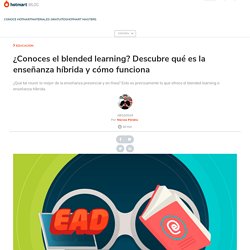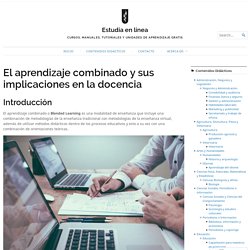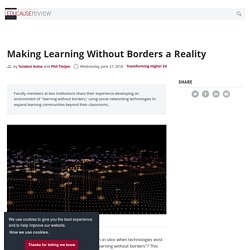

Blended learning: ¿Qué es enseñanza híbrida y cómo funciona? El blended learning, también conocido como enseñanza híbrida, aprendizaje mixto o b-learning, es un modelo educativo que busca combinar la enseñanza presencial con el aprendizaje remoto basado en la tecnología.

¿Quieres saber cómo funciona? ¡Sigue leyendo este artículo! El avance de Internet y de las nuevas tecnologías ha traído muchos cambios en la educación. Durante un tiempo, muchos creyeron que la modalidad presencial sería completamente reemplazada por la enseñanza a distancia. Sin embargo, ya existe un “camino intermedio”, más flexible, que aprovecha las ventajas de ambos modelos: el blended learning. Aunque es un término aún desconocido para muchas personas, la enseñanza híbrida se ha vuelto muy popular gracias a las transformaciones digitales.
El aprendizaje combinado y sus implicaciones en la docencia – Estudia en línea. Ciencias de la educación Introducción El aprendizaje combinado o Blended Learning es una modalidad de enseñanza que incluye una combinación de metodologías de la enseñanza tradicional con metodologías de la enseñanza virtual, además de utilizar métodos didácticos dentro de los procesos educativos y esto a su vez con una combinación de orientaciones teóricas.

Es importante remarcar que las personas no son aprendices de un método único, ya que cada uno aprende diferente, es por ello que el docente necesita conocer los diferentes modelos y técnicas de estudio, teniendo como resultado un aprendizaje integro. Desarrollo del tema Según Elliott Masie “La gente no aprende por un solo método, ya que somos como especie un alumno integrado”. Las siguientes combinaciones se pueden utilizar en el aprendizaje combinado: Making Learning Without Borders a Reality. Faculty members at two institutions share their experience developing an environment of "learning without borders," using social networking technologies to expand learning communities beyond their classrooms.

In higher education, why do we continue to learn in silos when technologies exist that enable us to promote an environment of "learning without borders"? This post is our attempt to answer this question. One of our shared interests is using social networking technologies not only to build local learning communities but to expand those communities beyond our classrooms. On the surface, this sounds obvious since these tools are often associated with making connections and bringing students together regardless of time and place. How Did We Do It? This collaborative project involved two classes oriented to exploring the role of technology for building knowledge-oriented communities: a graduate class from Oklahoma State University and an undergraduate class from Stockton University.
VENTAJAS DE LA MODALIDAD: APRENDIZAJE COMBINADO (BLENDED LEARNING) APRENDIZAJE COMBINADO COMO ESTRATEGIA DIDÁCTICA. 10 Tips for Effective Online Discussions. These tips can help educators ensure that online discussions are engaging and beneficial for postsecondary students. For many of today's students and more than a few educators, effective participation in online discussions in postsecondary education may not be second nature. In particular, graduate-level discussions present challenges quite different from their undergraduate counterparts, as master's degree candidates tend to be highly motivated. This may mean that they frequently exceed the minimum number of required posts and write longer entries.
The recommendations below are based on my own experience teaching fully online graduate courses with fifteen to twenty students, although many of these points would benefit those teaching at the undergraduate level as well. 1. It would be easy to hold online discussions to higher standards than discussions happening face-to-face. Be careful what you wish for, however! 2. 3. 4. 5. 6. Consider offering live discussions. 7. 8. 10 consejos para profesores que dan clase virtual por primera vez. At the time of this writing, colleges and universities around the world are cancelling face-to-face classes to slow the spread of coronavirus.

At nearly every institution of higher education, faculty are being asked to prepare for the possibility of teaching courses online. As an experienced online professor, here are my Top 10 Tips to help you transition to teaching online. Tip #1: Consider Teaching Asynchronously For the first few weeks of teaching online, it makes a lot of sense to meet synchronously with Zoom or WebEx.
Perhaps that’s all we’ll need and then it will be back to normal. What does that mean? Tip #2: Keep Course Navigation Simple and Obvious. Everything is harder for students online. Navigation should be stone-cold obvious. Tip #3: Build on Existing Content Professors have been teaching online lecture and lab courses for well over a decade and there’s an enormous number of quality educational resources already available for you to use with your students. Simulations.